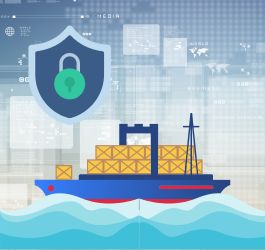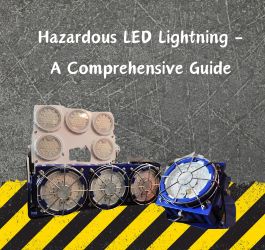Navigating the sea poses considerable challenges for marine vessels, given factors like saltwater exposure and the constant motion of the water. While protecting the hull and external surfaces is crucial, safeguarding the inner electrical components is equally vital.
The harsh marine conditions, marked by extreme temperatures and the corrosive impact of moisture, oil, and salt, accelerate the deterioration of essential system components. To ensure the longevity of your marine vessel's system, the choice of the right cable is paramount.
When configuring a ship, it is imperative to opt for a robust marine shipboard cable designed specifically to withstand the demanding marine environment. This specialized cable plays a pivotal role in maintaining the integrity and durability of the vessel's electrical system.Table Of Contents
What Is Marine Cable?

Marine cables are highly specialized electrical components meticulously crafted for use on marine vessels and ships. Analogous to veins and nerves in the human body, these cables play a pivotal role by facilitating communication and transmitting electrical power to various onboard systems.
In a manner similar to the wiring that interconnects and powers devices in a home, marine cables perform a parallel function but on a larger scale, tailored for the challenges of nautical environments.
Imagine sailing vessels without the essential elements of communication with the shore, illumination, and navigation systems. This scenario underscores the indispensability of marine cables in the realm of ship operations.
These cables undertake multifaceted roles, from enabling communication between the bridge and engine room to providing power for radars and engines.
In essence, marine cables play a crucial role in enhancing safety and ensuring an enjoyable maritime experience by keeping life at sea well-connected and well-lit.
Applications Of Marine Cables

Marine cables play a crucial role in diverse functions across boats, ships, and yachts. These include:
Power distribution
Marine cables are extensively used for power distribution on ships, providing electricity to various systems, equipment, and lighting throughout the vessel.
Communication systems
They are essential for ship-to-shore and internal communication systems. Marine data cables and marine telephone cables facilitate seamless communication between different sections of the ship and with onshore entities.
Instrumentation and control
Marine cables are used in instrumentation and control systems, including sensors and monitoring devices that contribute to the overall safety and operational efficiency of the ship.
Navigation and automation
In the era of autonomous and semi-autonomous vessels, marine cables play a crucial role in supporting navigation and automation systems. They enable data transfer and communication for autonomous navigation technologies.
Entertainment systems
Marine cables are used for the wiring and connectivity of entertainment systems on ships, including audiovisual equipment, Wi-Fi networks, and in-cabin entertainment.
Safety systems
Critical safety systems such as fire alarms, emergency lighting, and other safety protocols rely on the reliability of marine cables to function effectively during emergencies.
Lighting and power supply
Marine cables are integral for providing lighting solutions on ships. They ensure a stable power supply to various lighting fixtures, contributing to both safety and comfort on board.
Offshore platforms
Marine cables are employed in offshore installations, including oil and gas platforms, where they are subjected to challenging environmental conditions such as saltwater exposure and harsh weather.
Underwater applications
Specialized marine cables are designed for underwater applications, such as submersible pump cables, used in powering equipment beneath the water surface.
Cable management and installation
Marine cables are utilized in cable management systems, including cable trays and conduits, to organize and protect cables from damage during installation and while navigating rough waters.
Types Of Marine Cables
1. Power cables for electrical systems
Power cables are the lifeline of a ship's electrical systems, ensuring that the lights stay on and the engine operates smoothly. These cables play a crucial role in powering various components, ranging from propulsion systems to lighting fixtures.

One prevalent type of power cable, such as the QYEQEY ESP Cable, is the submersible pump cable, specifically designed to provide power to essential oil production equipment on ships.
2. Communication cables for data and signals
In straightforward terms, communication cables for data and signals are the backbone of ship-to-ship communication. Unlike the historical method of sailors using flags to convey messages across the waves, modern ships depend on these communication cables to transmit essential navigation data.

This technological advancement ensures that our crew members remain seamlessly connected, promoting smooth sailing and ensuring safe voyages. Within this category, diverse types, including marine data cables and marine telephone cables, cater to specific communication needs at sea.
Cable Components And Construction

While marine ship cables may seem unassuming in size, their intricate construction involves several key components to ensure optimal performance. Let's delve into the details.
| Conductor | Serves as the pathway for electric current within the cable |
| Conductor Screen | Safeguards the conductor against unwanted interference |
| Filler and Binding Tapes | Provide support and maintain secure positioning of internal cable components |
| Insulation | Prevents the electric current from diminishing |
| Insulation Screen | Adds an extra protective barrier to prevent any disruptions |
| Separation Tape | Keeps various components separated, averting unexpected issues |
| Inner Sheath (Bedding) | Offers an additional level of protection to the cable |
| Metallic Sheen | Provides protection against electromagnetic interference |
| Outer Sheath | Shields the entire marine data cable from the challenging underwater environment |
This meticulous assembly of components ensures the cable's resilience and effectiveness, allowing it to withstand the demanding conditions of marine environments.
How To Install Marine Cables?

Now that we've explored the construction of marine ship cables, let's delve into the techniques involved in their installation and understand how they are strategically laid out on the ship.
1. Cable tray installation
Picture the cable tray as the ship's meticulously organized storage unit. Cables are arranged within these trays to shield them from accidental damage and maintain a tidy and efficient layout.
2. Bundling and separation
Similar to how sailors neatly bundle and separate their rigging, marine cables require the same level of attention. Bundling ensures that cables are grouped together, adhering to specific pathways much like rigging lines.
This practice prevents interference between communication and power cables, preserving signal integrity.
3. Cable pulling
Just as sailors hoist sails, cables are gently pulled through designated pathways. Avoiding tight bends and sharp corners, the process resembles guiding the cables along well-planned routes to reach their intended destinations.
By employing these installation techniques, marine cables are not only safeguarded against potential damage but also organized in a manner that ensures optimal functionality, mirroring the precision and care observed in various maritime practices.
Maintenance Of Marine Cables

Following the installation of marine cables, it becomes imperative to implement effective maintenance practices, considering their costliness during replacements. To ensure the prolonged functionality of these cables, the following measures can be undertaken:
1. Cable routing and management on ships
Implementing a meticulously planned cable routing map on the ship. Securing ship cables in trays with appropriate supports to manage stress during the vessel's movements.
This method prevents entanglements, simplifying cable maintenance and ensuring their safe journey.
2. Installation methods and considerations
Detail-oriented installation using the right tools. Employing cable fasteners, ties, and cable glands for water-tight seals.
Selecting cables tailored to the ship's requirements and environment, such as Marine VFD Cables and Marine Control Cables.
3. Cable testing and troubleshooting
Ensuring a seamless connection on the high seas involves conducting thorough cable testing before each voyage to guarantee smooth signal flow and secure connections. Additionally, being prepared for unforeseen issues during the journey is crucial, requiring the implementation of effective troubleshooting measures.
It is imperative to fulfill safety requirements for ships concerning cable testing and troubleshooting, establishing a comprehensive and proactive approach to maintaining the integrity of the vessel's electrical systems.
4. Preventive maintenance and cable lifespan
Regular inspection, cleaning, and lubrication play a pivotal role in extending the lifespan of marine cables. Through proactive preventive maintenance, cable health is ensured, minimizing disruptions during voyages.
Upholding the cables in top-notch condition through these measures contributes significantly to their prolonged functionality and reliability on the high seas.
What Attributes Make Marine Cables Important?

The reliability of shipboard cables stems from their versatility, serving various functions within a marine vessel. Here are some noteworthy features that underscore their significance:
Corrosion resistance
A prevalent concern in marine cabling is the potential for corrosion. Marine shipboard cables feature tinned copper, enhancing their resistance to corrosion compared to cables intended for shore use.
Tinning fortifies copper's inherent properties, providing resistance to high temperatures, humidity, and wet environments.
Flexibility
Shipboard cables incorporate a robust yet flexible Low Smoke Zero Halogen, crucial for navigating tight spaces during installation. This flexibility streamlines cable handling, leading to shorter installation times.
Insulation
The Low Smoke Zero Halogen not only enhances flexibility but also serves as insulation, shielding the cable against fire, gas, humidity, and oil. This insulation ensures uninterrupted system functionality, minimizing risks.
Size
Distinctively larger than other instrument cables, marine shipboard cables contain more copper. The increased copper content enhances their carrying capacity, allowing them to accommodate higher electrical currents effectively.
In essence, these features collectively contribute to the resilience and efficiency of marine shipboard cables, making them integral components for seamless operations within marine vessels.
Practical Applications In Real World
Let's explore practical applications of marine cables in real-world scenarios, highlighting their crucial role in various maritime settings.
Cable installations aboard large cargo vessels

Numerous colossal cargo vessels navigate vast oceans, transporting substantial loads of treasures and goods. However, the question arises: how do these vessels stay powered and connected during their extensive voyages? Let's delve into the intricacies and understand how this process unfolds.
In the vast expanse of open water, there is no convenience of swiftly acquiring a replacement cable from the nearest store in case of a malfunction. Therefore, it is imperative to equip these marine cables with advanced materials, ensuring resilience against harsh conditions and safeguarding the cargo.
The robustness of marine cables is vital for maintaining communication and sustaining systems on these immense vessels. Their ability to endure challenging weather conditions and the corrosive nature of salty sea air ensures a steadfast and reliable connection throughout the journey of these cargo ships.
An interesting point to note is that the sizes of these marine cables for ships vary, mirroring the diversity of their cargo. Ranging from data cables facilitating communication to electric cables providing lighting and power, these cables collaborate seamlessly to ensure the smooth navigation of cargo.
Utilization of marine cables in passenger cruise ships

Marine cables play a vital role beyond providing a serene getaway on ships. From the moment passengers step aboard, these cables actively contribute in various ways. They maintain a pleasant atmosphere by powering air conditioning, illuminate cabins with bright lights, and enable entertainment systems to deliver movies and shows during the cruise.
Moreover, the seamless Wi-Fi connections on ships, enhancing the overall vacation experience, depend on the reliability of these cables. Beyond entertainment, marine cables are integral for safety measures.
They interconnect critical systems such as emergency lighting and fire alarms, ensuring the safety of everyone on board. Additionally, effective communication among the crew heavily relies on the functionality of marine cables, contributing to the smooth operation of the ship.
What Types Of Marine Cable BH eStore Sells?
| Marine Cables | Offshore Cables |
Power Cables LV 0.6/1KV [Cores type]
| Power Cables LV 0.6/1KV [Cores type]
|
Instrumentation Cables LV 250V [Pairs, Triads, Quads]
| Instrumentation Cables 250V [Pairs, Triads, Quads]
|
Verdict: Should I Get Marine Cables?

Marine electrical cables play a pivotal role in safeguarding the dependable and secure functioning of electrical systems aboard marine vessels. It is imperative to make informed choices in cable selection, considering factors such as construction, components, voltage specifications, environmental resilience, and adherence to industry standards. This ensures the establishment of a robust and reliable electrical infrastructure.
Adhering to proper installation techniques, adopting effective maintenance protocols, and implementing troubleshooting methods are integral steps for optimal performance and safety. This comprehensive guide serves as a roadmap for marine vessel owners, empowering them to uphold the longevity, efficiency, and safety of their marine electrical cables.
Through these measures, a seamless and worry-free sailing experience is not only facilitated but also guaranteed.










